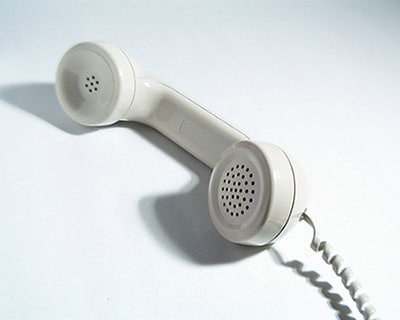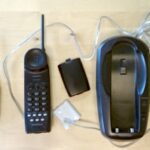Back in the days of rotary dial-up, you paid a monthly fee for certain “local” or “semi-local” calls from a telephone provider, and if you were ahead of the times you shopped around for a better deal for long-distance rates.
This is a comprehensive buying guide for home telephones. Includes VoIP phones, a corded vs cordless comparison, analog vs digital, and more.
Many companies, such as Verizon and AT&T, are beginning to reduce their landline rates because so many people are using their cell phones as their primary phone devices, thus eliminating landlines and even cordless phones. At the same time, companies are expanding their fiber-optic networks, which allow them to compete with cable providers to offer a full array of telecom services.
Most cable companies now regularly provide phone service, commonly referred to as telephony, and the cable telephony option continues to grow. Cablevision was the pioneer in the cable world to include telephone service, but in the last few years Comcast has led the market. To try to convert more phone customers, cable now uses fiber in parts of its networks.
With an abundance of technologies available today, many phone companies are turning to bundling (also called double-play or triple-play packages). Bundling means companies offer a monthly rate for your local landline service, long-distance service, Internet service, and even your cell phone service and television.
Bundling offers convenient consolidation of your telecom bills, but with so many plans out there comparisons can be difficult to assess. Bundling usually involves at least a one-year contract, and the lowest offer is typically a $99-per-month package, though it usually includes a premium level of television service, standard-speed broadband Internet service, and telephone service with a variety of calling features.
Satellite TV providers cannot alone offer bundles, but they are increasingly partnering with phone companies to create bundles comprising satellite TV, DSL Internet, and landline phone service.
VoIP Internet Telephones
Voice over Internet Protocol (VoIP) is a protocol optimized for the transmission of voice through the Internet or other packet-switched networks.
An IP phone uses Voice over IP technologies allowing telephone calls to be made over an IP network such as the Internet or a private IP network instead of the ordinary public switched telephone networks (PSTN or the telephone line). This type of phone has a regular phone jack and an Ethernet jack for hookup to your home computer network.
IP phones look like ordinary landline phones or cordless phones. But with these phones, you simply switch back and forth between a regular phone jack and an Ethernet jack. If you make long-distance calls frequently, this system is a major boon to saving money. All you need is the required high-speed Internet access.
Common features of IP phones include caller ID, dialing using name ID, locally stored and network-based directories, conference calling, call park, call transfer, and call hold. You can also include applications such as weather report, attendance in school and offices, and news.
The problems with IP networks are that they are easily congested, the voice quality may not be good, or your call may even be dropped. Additionally, VoIP phones do not work as well with satellite Internet and other high-speed Internet connections, and it can be a challenge to route VoIP traffic through firewalls and address translators.
The security of IP phones is still unclear. Also, like cordless phones, your IP phone is dependent on your home’s power source.
Finally, VoIP phones have had problems dialing emergency numbers because the IP system might not be easily routed to a nearby emergency call center. Sometimes, VoIP systems may instead route emergency calls to a non-emergency phone line at the intended department.
To offset this problem, VoIP providers must support emergency services by offering an E911 emergency calling system to its customers for an additional cost. Participation in E911 is not required but has been successfully used by many VoIP services to provide physical address information to emergency service operators. One setback, however, is the diligence of the customer to keep emergency address information up to date, since the burden of responsibility is on the subscriber and not the service provider.
Other VoIP options include a “soft phone,” which is software-based, where calls can only be placed from the computer on which the “soft phone” software resides. You may be able to connect your traditional analog phones directly to a VoIP phone adapter without the need to operate a computer. The converted analog phone signal can then be connected to multiple house phones or extensions.
Choosing a Landline Phone
How you choose a landline phone depends primarily on how you want to use it and how much you want to spend. Following is a list of considerations to assist you in choosing a landline phone for your home.
• Determine whether you want just a phone or a phone/answering machine. If you want a phone with an answering machine, consider the voice quality for recorded messages and greetings. Most phones allow you to record your greeting through the handset, which provides for better voice quality. Plus, you can also listen to the greeting through the handset, so you know how the greeting sounds to the calling party.
Answering machines have many features, including number of rings before the machine picks up, an on/off control switch, call screening, remote access, and speaker volume control.
• How many phones lines do you want? A phone that supports two phone lines can receive calls from two different phone numbers. This is desirable for a home that wants one line for business calls and the other line for personal calls. These phones can also have two different ringers, with the distinctive pitch telling you which line is ringing.
• Choose a frequency. If you have few or no wireless devices near your phone, consider a 2.4-gigahertz band. If you have a lot of wireless devices, you may want to look into devices called “wireless network friendly” or “802.11-friendly.”
• How many bells and whistles do you want? Do you want caller ID, speakerphone capability, or conferencing capability? A mute button allows you to mute the incoming call, thus allowing you to converse with someone else in your location without the caller listening in. A predictable rule of thumb: the more features, the higher the price.
• Do you want the base able to be wall mounted?
• While at the store, try out the handset. Does it fit in your hand comfortably? Does it fit the contours of your face, and does the earpiece feel comfortable over your ear. Are the buttons and controls an adequate size?
• Do you want analog or digital technology?
• Does your phone have a battery backup? Battery backups are important because they protect the phone’s memory in case the phone is unplugged. Note that batteries are usually not included with your phone purchase.
• Make sure to check the phone’s packaging to confirm you’re getting the features you want.
Corded Phones vs Cordless Phones
Even though corded phones are going the way of the dinosaur, it is still a good idea to keep at least one corded phone in your home in case of a power outage. Without electrical power, cordless phones and some corded phones that are connected to VoIP services or fiber-optic networks may not work if you lose electrical power.
Cordless phones also typically lose signals, or the circuits become full during power outages or emergencies. A corded phone is a reliable option because its power source does not come from your utility company but rather from the telephone exchange, which has extensive backup systems.
Corded phones also offer top voice quality. Even the best cordless phones on the market cannot match the voice quality offered by a corded telephone.
Still, cordless phones are winning the popularity contest. Cordless telephones typically provide secure and reliable voice communication with the portability you cannot get with a corded phone.
Analog vs Digital Cordless Phones
The main difference in cordless phones is the way in which they transmit their signals.
Analog phones are the least expensive telephones, and analog transmissions typically have good voice quality and few interference problems.
The problems with analog are that the range is shorter and the transmissions are not very secure. Analog multiple-handset-capable phones also cannot conference handsets with an outside party. Additionally, the number of handsets that can be supported by the base unit is usually only two.
Digital phones sound clearer, are noted for better security and slightly longer range, and provide more immunity to RF interference. Be aware, however, that phones that come with verbiage such as “phone with all-digital answerer” or “spread spectrum technology” are less secure devices.
There are two types of digital technology:
DECT (Digital Enhanced Cordless Telecommunications) is the new technology utilizing the 1.9-gigahertz frequency. DECT allows for less interference and almost 16 hours of talk time before the handset needs recharging.
DSS (or Digital Spread Spectrum) enables the digital information to “frequency hop” between the receiver and the base, thereby making it almost impossible to eavesdrop on a cordless conversation. Some DSS phones are billed as “802.11 friendly” or “wireless network friendly,” which means they are unlikely to interfere with wireless computer networks, but that does not mean they won’t interfere with other wireless products.
Dual-band phones are those that transmit between base and handset in one frequency and receive in another. You cannot switch one band for another.
Some phones that advertise dual-band models list the higher frequency in larger print on the packaging. So, if you want a true 5.8-gigahertaz phone, check the fine print, because if only the higher frequency is shown on the package, it’s probably an analog phone.
A Guide to Cordless Phones
Cordless phones first appeared around 1980. It wasn’t until 1994, however, that they became more affordable and reliable, using the 900-megahertz frequency. Cordless phones allow you to talk on the phone while moving freely about your house or in your yard. Basically, the cordless telephone is a combination telephone and radio transmitter/receiver.
There are two major parts: the base and the handset.
The base is connected to the phone jack through a standard phone-wire connection and a power source. The base receives the incoming call as an electrical signal through the phone line, converts it to an FM radio signal, and then broadcasts that signal.
The handset receives that signal, converts it to an electrical signal and then sends that signal to the speaker, where it is converted into the sound you hear when the phone rings.
Talking into the receiver involves a second FM-radio signal being sent back to the base. The base reverses what it did originally, to send your voice to the calling party.
The base and handset operate on a frequency pair—called duplex frequency— that allows you to talk and listen at the same time.
Because cordless phones are a combination of a telephone and a radio transmitter/ receiver, they are subject to similar problems as radio transmissions: range (the distance the handset can be from the base), sound quality, and security. Sound quality is related to range because the quality decreases the farther away from the base the handset travels. Security is a problem because the radio signals go over the open airways.
Cordless phones transmit their signals between the base and the handset wirelessly in two of the five available radio frequency bands using analog or digital technology (cordless phones use two closely related but separate frequencies within the band, so that you can talk and listen at the same time). These bands are set by the FCC (Federal Communications Commission) and are as follows:
1) The first cordless phones used a 43–50 megahertz band, and they are still available today in low-cost, low-range models. They generally have the poorest sound quality due to the low frequency and the interference from structures and appliances.
2) 900 megahertz is the most commonly used frequency and offers a good range. The problem with the 900-megahertz spectrum is that it is cluttered, which means interference problems can come from such other 900-megahertz products as baby monitors and radio scanners.
3) 2.4-gigahertz offers better clarity and security than 900-megahertz, but interference problems may occur from microwave ovens and wireless networking devices. Recent interference problems with 2.4-frequency analog phones have been eased by products that avoid portions of the 2.4 band used by wi-fi networks.
4) 5.8-gigahertz is used by the most advanced cordless phones. Generally, they will not interfere with wi-fi products, but be aware that some products billed as 5.8-gigahertz phones actually use both 5.8- and 2.4-gigahertz frequencies.
5) 1.9-gigahertz is used on DECT 6.0 devices and is becoming more and more popular as the 2.4 and 5.8 frequencies are increasingly overburdened. The 1.9 frequency has been used for many years in Europe but only recently approved in the United States. Because of the congestion of the other two frequencies, the 1.9 frequency is reserved for voice applications only. This was approved to eliminate interference with wi-fi networks, the Bluetooth, baby monitors, and other wireless devices, and to increase clarity and security.
Cordless Telephone Features
When purchasing a cordless phone, consider the following:
• How many handsets do you want? And do you want each handset to have its own base?
• Make sure the batteries in the handset(s) on your cordless phone(s) can sustain approximately eight hours of continuous talking for four to seven days before needing a recharge.
• There will come a time when your handset battery can no longer hold a charge. Make sure you can locate a replacement battery when you purchase your phone. The replacement battery can cost $10 to $25; however, some phones use only AA or AAA batteries, which are much less expensive.
• Try to purchase a cordless phone with a DSS system, to ensure the security of your phone conversations.
• Some cordless phones have a speaker option on the handset, which allows you to place a call on speaker without having to use the base.
• If you commonly misplace your cordless phone, purchase one with a page/handset locator, a feature that allows you to send an auditory signal from the base of the phone to the handset.
• All phones have ringers, but some cordless phones have ringers on the base and the handset. Not all, however, allow you to set the ringers to an “on” or “off” position, adjust the volume, or change the ringer tone.
• Some cordless phones come with multiple handsets that can be used as walkie-talkies, handset to handset.
• If you want to reduce the number of telemarketing calls you receive, look for phones that have a built-in TeleZapper.
• Some phones have a built-in security feature in which digital verification between the base and handset prevents your dial tone from being intercepted and used to make calls on your line.
• Can my cell phone interact with my cordless phone? The answer is yes, because some cordless models can stand in for your cell phone if you place the cell phone near the cordless phone’s base. Via Bluetooth technology, you can access your wireless service and, as a result, use your cordless handset to make or take cell calls. The bonus is being able to use any of your cell phone plan’s unused minutes rather than accumulate minutes against your standard phone account.
• Other cordless phone features include redial, earpiece volume control, paging ability, tone/pulse dialing, and built-in phone book.








 Don Vandervort writes or edits every article at HomeTips. Don has:
Don Vandervort writes or edits every article at HomeTips. Don has:



